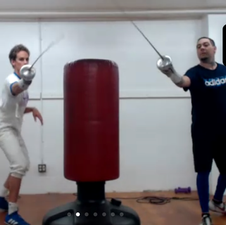Online Fencing classes like no other on Zoom
We took on the challenge of moving our fencing classes online to zoom and our kids are loving it.
Some are showing remarkable improvements in fencing because we are engaging and keeping them very fit without distractions.
With our exhausting variation of stretches, weight training, foot-work and blade-work skills these students are spending an hour totally absorbed.
What makes these classes so different:
While coaches, Barret and Zack demonstrate the moves and lead all the exercises, owner and Olympian, Elaine Cheris keeps an eye on every student; keeping them on track, focussed and doing each activity correctly. Elaine gets down to the technical level, matching the expectation of skill to the experience level of the fencer. Making sure the kids are in total view so she can see that every foot and arm extension, parry, riposte, seconde, prime, coupe, lunge, bounce, advance or retreat is carried out in the correct manner.
Yes, they do all these technical moves but it is not necessary to know all these moves yet as Elaine adjusts to the different levels of expertise. Even owning an epee sword is not a requirement; practicing with a small broom handle, stick or even a toy sword or light saber will work.
Elaine also wrote a book that is an excellent complement to these online classes showing all the steps to building and refining your fencing skills. The book Fencing: Steps to Success is available from Human Kinetics.
In these Fencing classes, Elaine continually directs and questions whether a student knows a particular move, and further specific instruction is given where needed including a live, slowed-down, close-up of the specific action that needs correcting.
The kids get to suggest their favorite exercises and provide feedback to Elaine on likes and dislikes of each class. No wonder they love these classes but they still can’t wait to get back to the club to put their newly honed skills to the test in a fencing bout.
The class starts with stretches of all the major muscles used in fencing, which may remind some parents of their yoga classes, followed by some quick simple blade exercises to warm up that fencing arm. Then onto more rigorous exercises to get the blood pumping: push ups, sit-ups, plank pose, boat pose, star jumps, burpees, and other aerobic activities.
These are followed by repetitions of fencing moves that are called out by Elaine, demonstrated by the coaches and followed by the student on cue. For example: bounce-advance-lunge, advance, balestra (where the student almost slaps the front lunge foot on the floor while moving forward somewhat like a horse)-retreat-lunge, 45 bounces waiting for the cue to lunge, then cross over lunge.
Weight training is next: from laterals with arms straight, frontals, biceps to wrist curls there is little time to rest except for a few water breaks.
Now the more complicated fencing moves start but no student is left to fumble through. Each class focusses on some different fencing skill but all the fundamental skills are repeated each class.
Students are loving our online Fencing classes












